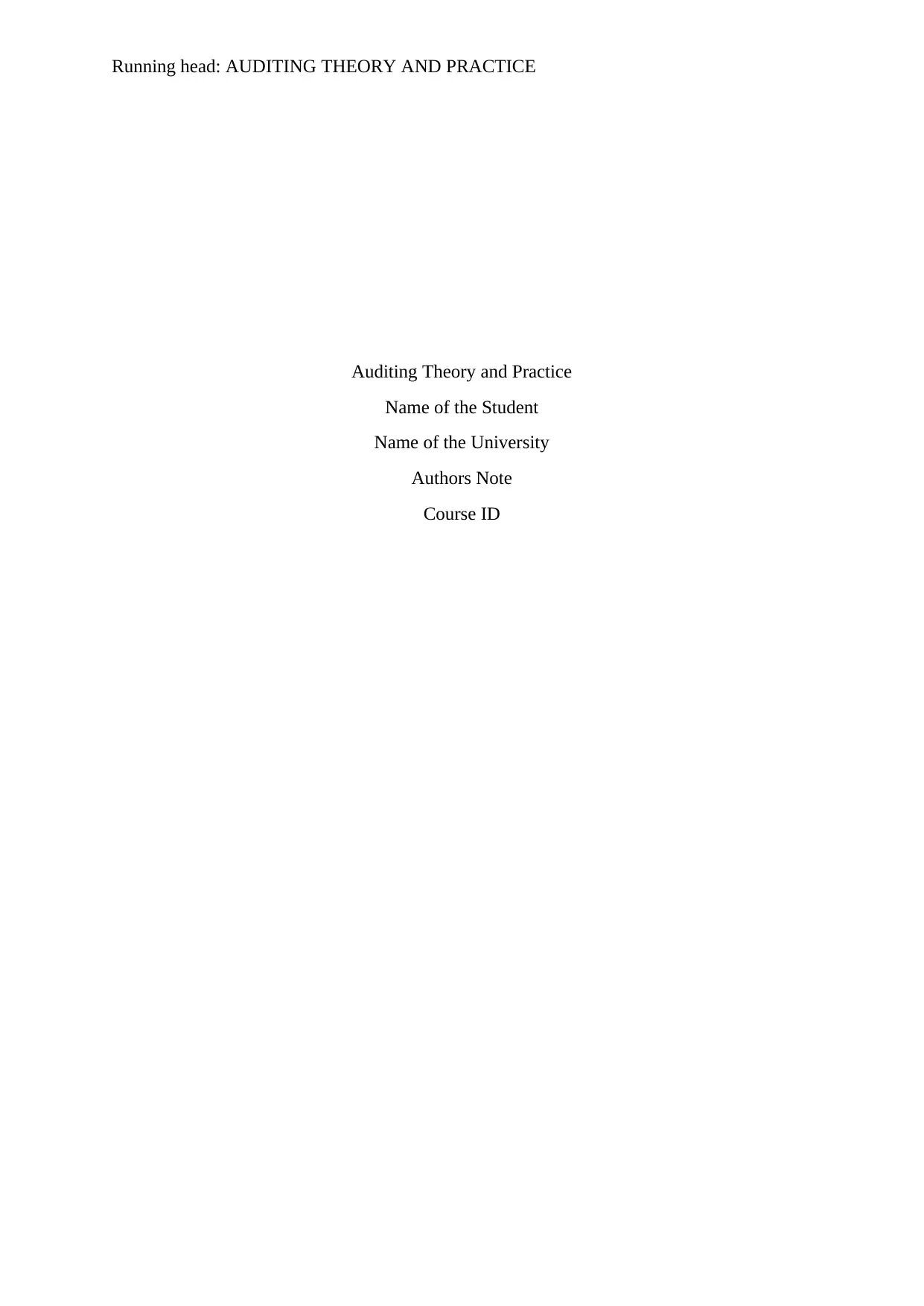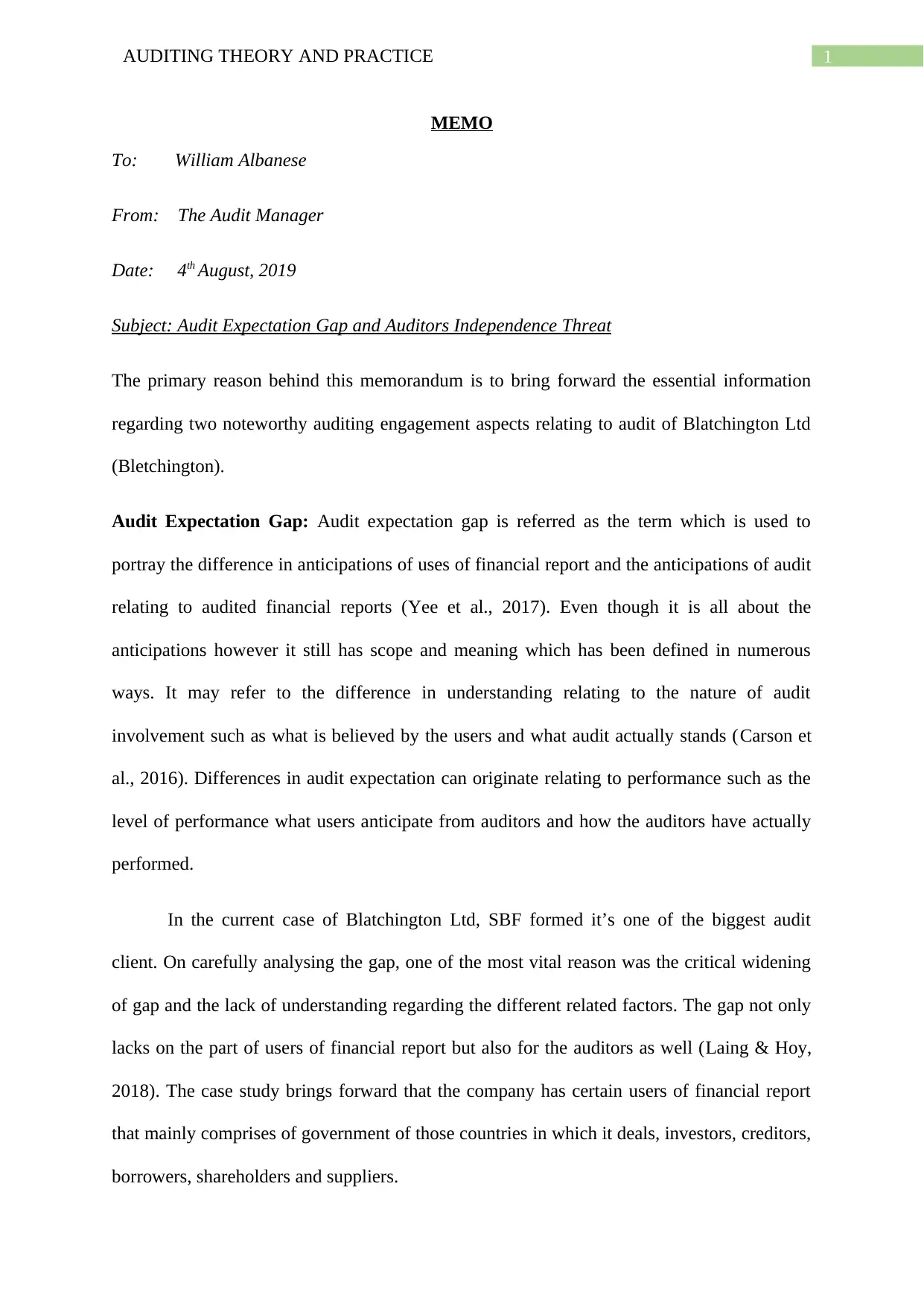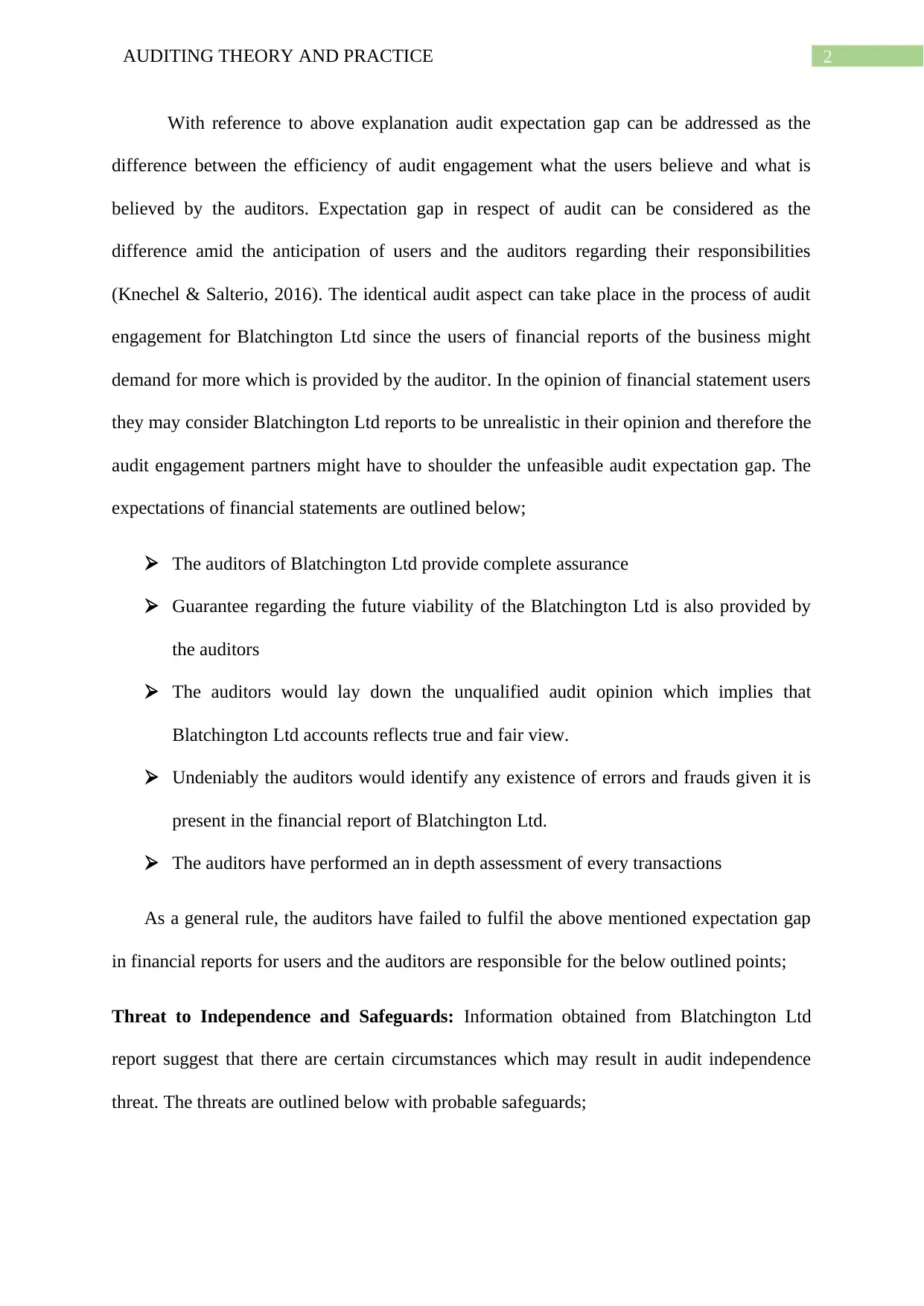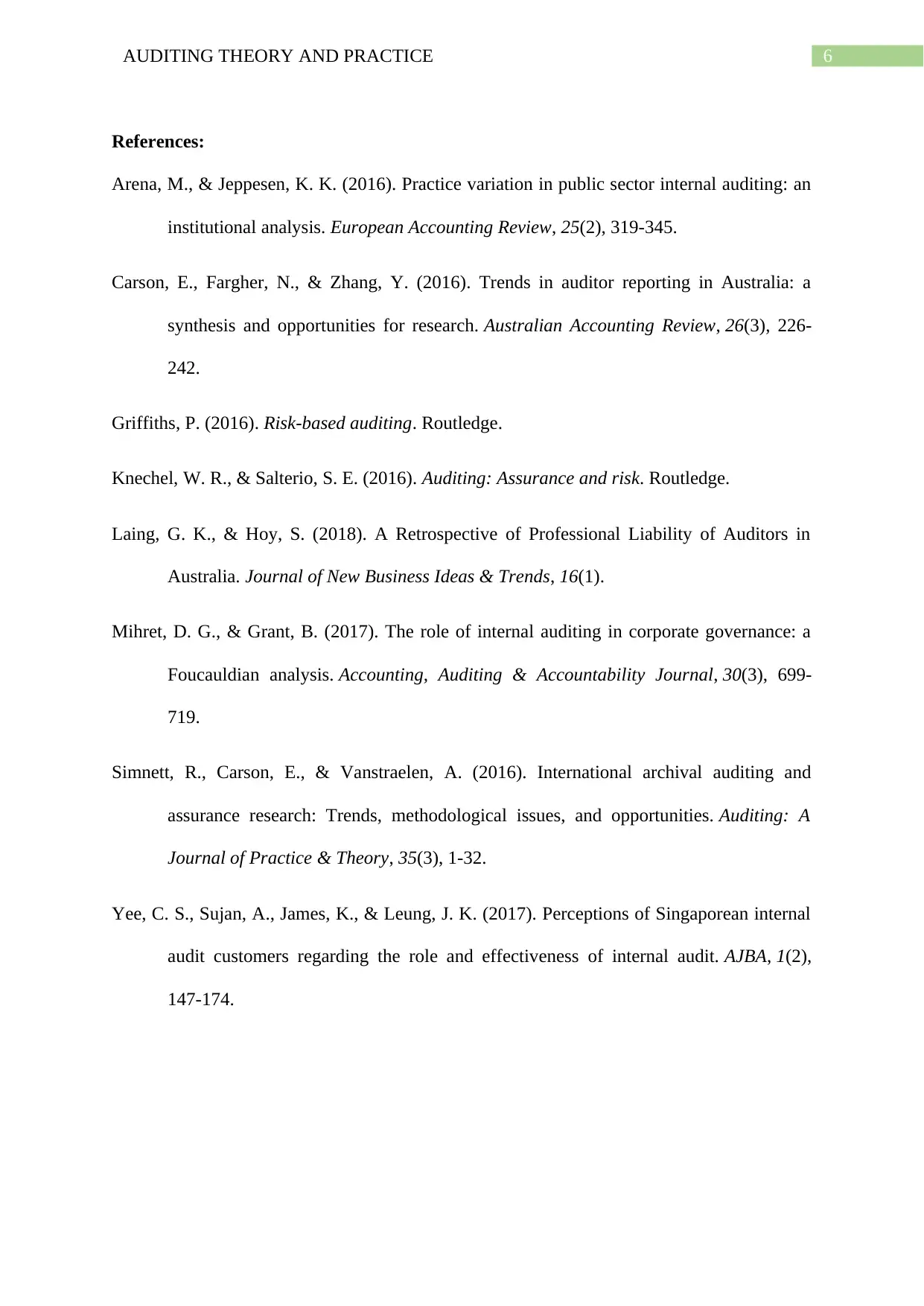Auditing Theory and Practice: Expectation Gap and Threats
VerifiedAdded on 2022/10/11
|7
|1621
|25
Report
AI Summary
This report examines the audit expectation gap and threats to auditor independence within the context of auditing theory and practice, using the case of Blatchington Ltd. It begins by defining the audit expectation gap, highlighting the differences between user and auditor expectations, and identifies the various stakeholders of financial reports. The report then delves into potential threats to auditor independence, including self-interest, self-review, and familiarity threats, as defined by APES 110. For each threat, specific examples are provided based on the Blatchington Ltd case, followed by recommended safeguard measures to mitigate these risks. The report emphasizes the importance of external reviews, professional monitoring, and disciplinary procedures to ensure audit objectivity and maintain public trust. The analysis underscores the critical need for auditors to address these issues to uphold the integrity of financial reporting.

Running head: AUDITING THEORY AND PRACTICE
Auditing Theory and Practice
Name of the Student
Name of the University
Authors Note
Course ID
Auditing Theory and Practice
Name of the Student
Name of the University
Authors Note
Course ID
Paraphrase This Document
Need a fresh take? Get an instant paraphrase of this document with our AI Paraphraser

1AUDITING THEORY AND PRACTICE
MEMO
To: William Albanese
From: The Audit Manager
Date: 4th August, 2019
Subject: Audit Expectation Gap and Auditors Independence Threat
The primary reason behind this memorandum is to bring forward the essential information
regarding two noteworthy auditing engagement aspects relating to audit of Blatchington Ltd
(Bletchington).
Audit Expectation Gap: Audit expectation gap is referred as the term which is used to
portray the difference in anticipations of uses of financial report and the anticipations of audit
relating to audited financial reports (Yee et al., 2017). Even though it is all about the
anticipations however it still has scope and meaning which has been defined in numerous
ways. It may refer to the difference in understanding relating to the nature of audit
involvement such as what is believed by the users and what audit actually stands (Carson et
al., 2016). Differences in audit expectation can originate relating to performance such as the
level of performance what users anticipate from auditors and how the auditors have actually
performed.
In the current case of Blatchington Ltd, SBF formed it’s one of the biggest audit
client. On carefully analysing the gap, one of the most vital reason was the critical widening
of gap and the lack of understanding regarding the different related factors. The gap not only
lacks on the part of users of financial report but also for the auditors as well (Laing & Hoy,
2018). The case study brings forward that the company has certain users of financial report
that mainly comprises of government of those countries in which it deals, investors, creditors,
borrowers, shareholders and suppliers.
MEMO
To: William Albanese
From: The Audit Manager
Date: 4th August, 2019
Subject: Audit Expectation Gap and Auditors Independence Threat
The primary reason behind this memorandum is to bring forward the essential information
regarding two noteworthy auditing engagement aspects relating to audit of Blatchington Ltd
(Bletchington).
Audit Expectation Gap: Audit expectation gap is referred as the term which is used to
portray the difference in anticipations of uses of financial report and the anticipations of audit
relating to audited financial reports (Yee et al., 2017). Even though it is all about the
anticipations however it still has scope and meaning which has been defined in numerous
ways. It may refer to the difference in understanding relating to the nature of audit
involvement such as what is believed by the users and what audit actually stands (Carson et
al., 2016). Differences in audit expectation can originate relating to performance such as the
level of performance what users anticipate from auditors and how the auditors have actually
performed.
In the current case of Blatchington Ltd, SBF formed it’s one of the biggest audit
client. On carefully analysing the gap, one of the most vital reason was the critical widening
of gap and the lack of understanding regarding the different related factors. The gap not only
lacks on the part of users of financial report but also for the auditors as well (Laing & Hoy,
2018). The case study brings forward that the company has certain users of financial report
that mainly comprises of government of those countries in which it deals, investors, creditors,
borrowers, shareholders and suppliers.

2AUDITING THEORY AND PRACTICE
With reference to above explanation audit expectation gap can be addressed as the
difference between the efficiency of audit engagement what the users believe and what is
believed by the auditors. Expectation gap in respect of audit can be considered as the
difference amid the anticipation of users and the auditors regarding their responsibilities
(Knechel & Salterio, 2016). The identical audit aspect can take place in the process of audit
engagement for Blatchington Ltd since the users of financial reports of the business might
demand for more which is provided by the auditor. In the opinion of financial statement users
they may consider Blatchington Ltd reports to be unrealistic in their opinion and therefore the
audit engagement partners might have to shoulder the unfeasible audit expectation gap. The
expectations of financial statements are outlined below;
The auditors of Blatchington Ltd provide complete assurance
Guarantee regarding the future viability of the Blatchington Ltd is also provided by
the auditors
The auditors would lay down the unqualified audit opinion which implies that
Blatchington Ltd accounts reflects true and fair view.
Undeniably the auditors would identify any existence of errors and frauds given it is
present in the financial report of Blatchington Ltd.
The auditors have performed an in depth assessment of every transactions
As a general rule, the auditors have failed to fulfil the above mentioned expectation gap
in financial reports for users and the auditors are responsible for the below outlined points;
Threat to Independence and Safeguards: Information obtained from Blatchington Ltd
report suggest that there are certain circumstances which may result in audit independence
threat. The threats are outlined below with probable safeguards;
With reference to above explanation audit expectation gap can be addressed as the
difference between the efficiency of audit engagement what the users believe and what is
believed by the auditors. Expectation gap in respect of audit can be considered as the
difference amid the anticipation of users and the auditors regarding their responsibilities
(Knechel & Salterio, 2016). The identical audit aspect can take place in the process of audit
engagement for Blatchington Ltd since the users of financial reports of the business might
demand for more which is provided by the auditor. In the opinion of financial statement users
they may consider Blatchington Ltd reports to be unrealistic in their opinion and therefore the
audit engagement partners might have to shoulder the unfeasible audit expectation gap. The
expectations of financial statements are outlined below;
The auditors of Blatchington Ltd provide complete assurance
Guarantee regarding the future viability of the Blatchington Ltd is also provided by
the auditors
The auditors would lay down the unqualified audit opinion which implies that
Blatchington Ltd accounts reflects true and fair view.
Undeniably the auditors would identify any existence of errors and frauds given it is
present in the financial report of Blatchington Ltd.
The auditors have performed an in depth assessment of every transactions
As a general rule, the auditors have failed to fulfil the above mentioned expectation gap
in financial reports for users and the auditors are responsible for the below outlined points;
Threat to Independence and Safeguards: Information obtained from Blatchington Ltd
report suggest that there are certain circumstances which may result in audit independence
threat. The threats are outlined below with probable safeguards;
⊘ This is a preview!⊘
Do you want full access?
Subscribe today to unlock all pages.

Trusted by 1+ million students worldwide

3AUDITING THEORY AND PRACTICE
Issue Description Safeguard Measures
Threat of Self-Interest Denoting to paragraph
100.12 (1), APES 110,
evidences relating to self-
interest can be seen when
the financial or other forms
of interest might result in
inappropriate influence on
the behaviour or judgement
of auditors (Simnett et al.,
2016). Referring to
paragraph 200.4, APES 110,
there may be evidences of
self-interest threat when
there is an unnecessary
dependence on the audit
company regarding the
overall fees of the clients.
As understood in case of
SBF, Blatchington is the
biggest audit client for the
audit firm based on the
revenues earned from it and
there is an unnecessary
dependence on Blatchington
by SBF in respect of total
fees. This may result in the
threat of self-interest
relating to audit
independence when the firm
is largely concerned for its
probable loss of vital client.
In case of SBF, the
probability of audit
independence threat is
witnessed on the basis of
fees charged and the firm
cannot afford to lose them.
The audit objectivity might
be compromised in this case.
In order to safeguard the
problems regarding the
threat to audit independence
it is necessary to carry-out
an external review with the
help of third party
authorization relating to
audit reports, returns or
statements given by the
auditors where it can
identify the threat of audit
objectivity or any such
existence of biasness in
audit reports.
Self-Review Threat As given in paragraph
100.12 (b), of the APES 110
there might be situation of
self-review threat regarding
the audit independence
where the auditor may fail to
provide a correct assessment
or judgements to the
member of firm or the
auditor might continue their
To apply the safeguard
measures, it is important to
make sure that internal audit
team do not have any
indulgence in application,
training and selection of any
accounting system since the
internal audit team is
responsible for providing its
report on operational
Issue Description Safeguard Measures
Threat of Self-Interest Denoting to paragraph
100.12 (1), APES 110,
evidences relating to self-
interest can be seen when
the financial or other forms
of interest might result in
inappropriate influence on
the behaviour or judgement
of auditors (Simnett et al.,
2016). Referring to
paragraph 200.4, APES 110,
there may be evidences of
self-interest threat when
there is an unnecessary
dependence on the audit
company regarding the
overall fees of the clients.
As understood in case of
SBF, Blatchington is the
biggest audit client for the
audit firm based on the
revenues earned from it and
there is an unnecessary
dependence on Blatchington
by SBF in respect of total
fees. This may result in the
threat of self-interest
relating to audit
independence when the firm
is largely concerned for its
probable loss of vital client.
In case of SBF, the
probability of audit
independence threat is
witnessed on the basis of
fees charged and the firm
cannot afford to lose them.
The audit objectivity might
be compromised in this case.
In order to safeguard the
problems regarding the
threat to audit independence
it is necessary to carry-out
an external review with the
help of third party
authorization relating to
audit reports, returns or
statements given by the
auditors where it can
identify the threat of audit
objectivity or any such
existence of biasness in
audit reports.
Self-Review Threat As given in paragraph
100.12 (b), of the APES 110
there might be situation of
self-review threat regarding
the audit independence
where the auditor may fail to
provide a correct assessment
or judgements to the
member of firm or the
auditor might continue their
To apply the safeguard
measures, it is important to
make sure that internal audit
team do not have any
indulgence in application,
training and selection of any
accounting system since the
internal audit team is
responsible for providing its
report on operational
Paraphrase This Document
Need a fresh take? Get an instant paraphrase of this document with our AI Paraphraser

4AUDITING THEORY AND PRACTICE
dependency to form an audit
opinion while providing
audit services (Griffiths,
2016). According to APES
110, under paragraph 200.5
examples associated to self-
review threat regarding audit
independence provides
reports on assurance which
the audit firm issues relating
to efficiency in financial
reporting related to internal
control after designing the
system (Arena & Jeppesen,
2016). Evidences obtained
suggest that the internal
audit team and functional
staff of Blatchington were
mainly involved in selecting,
training and applying the off
shelf costing system which
is bought forward to assure
the effective costing of
tender and broader
requirements relating to
reporting is met. The audit
team is similarly responsible
for providing the assurance
report on operational
efficiency of shelf costing
system. Thus, this may
contribute to the
development of self-review
threat in audit independence.
efficiency of installed
accounting system. The
presence of efficient
professional or regulatory
monitoring committee
should be assured to keep
track of internal audit team.
Threat of Familiarity As explained under
paragraph 100.12 (b) of the
APES 110, there can be
instances relating to
familiarity threat of
independence when there
are close relationship
between the client and
auditors as this may lead to
auditor being very
sympathetic or turnout to be
very compliant in their work
(Mihret & Grant, 2017).
Denoting the explanation
made under paragraph 200.7
of the APES 110, there may
To eliminate the threat of
familiarity, certain safeguard
measures such as application
of professional or regular
monitoring along with
disciplinary procedure can
be implemented.
Consequently this will help
in constantly monitoring the
activities of internal audit
team.
dependency to form an audit
opinion while providing
audit services (Griffiths,
2016). According to APES
110, under paragraph 200.5
examples associated to self-
review threat regarding audit
independence provides
reports on assurance which
the audit firm issues relating
to efficiency in financial
reporting related to internal
control after designing the
system (Arena & Jeppesen,
2016). Evidences obtained
suggest that the internal
audit team and functional
staff of Blatchington were
mainly involved in selecting,
training and applying the off
shelf costing system which
is bought forward to assure
the effective costing of
tender and broader
requirements relating to
reporting is met. The audit
team is similarly responsible
for providing the assurance
report on operational
efficiency of shelf costing
system. Thus, this may
contribute to the
development of self-review
threat in audit independence.
efficiency of installed
accounting system. The
presence of efficient
professional or regulatory
monitoring committee
should be assured to keep
track of internal audit team.
Threat of Familiarity As explained under
paragraph 100.12 (b) of the
APES 110, there can be
instances relating to
familiarity threat of
independence when there
are close relationship
between the client and
auditors as this may lead to
auditor being very
sympathetic or turnout to be
very compliant in their work
(Mihret & Grant, 2017).
Denoting the explanation
made under paragraph 200.7
of the APES 110, there may
To eliminate the threat of
familiarity, certain safeguard
measures such as application
of professional or regular
monitoring along with
disciplinary procedure can
be implemented.
Consequently this will help
in constantly monitoring the
activities of internal audit
team.

5AUDITING THEORY AND PRACTICE
be an event of familiarity
threat in the audit
independence when the
auditor of auditing client or
an employee holding the
position to head the audit
engagement has recently
served as the audit
engagement partner.
Accordingly it is noticed
that Kev Kevanna leads
Bletchington internal audit
team and formerly an audit
partner of SBF. As a result
there may be a threat of
familiarity regarding the
audit independence where
Kev may leak some vital
information to SBF which
may create an influence on
audit involvement.
be an event of familiarity
threat in the audit
independence when the
auditor of auditing client or
an employee holding the
position to head the audit
engagement has recently
served as the audit
engagement partner.
Accordingly it is noticed
that Kev Kevanna leads
Bletchington internal audit
team and formerly an audit
partner of SBF. As a result
there may be a threat of
familiarity regarding the
audit independence where
Kev may leak some vital
information to SBF which
may create an influence on
audit involvement.
⊘ This is a preview!⊘
Do you want full access?
Subscribe today to unlock all pages.

Trusted by 1+ million students worldwide

6AUDITING THEORY AND PRACTICE
References:
Arena, M., & Jeppesen, K. K. (2016). Practice variation in public sector internal auditing: an
institutional analysis. European Accounting Review, 25(2), 319-345.
Carson, E., Fargher, N., & Zhang, Y. (2016). Trends in auditor reporting in Australia: a
synthesis and opportunities for research. Australian Accounting Review, 26(3), 226-
242.
Griffiths, P. (2016). Risk-based auditing. Routledge.
Knechel, W. R., & Salterio, S. E. (2016). Auditing: Assurance and risk. Routledge.
Laing, G. K., & Hoy, S. (2018). A Retrospective of Professional Liability of Auditors in
Australia. Journal of New Business Ideas & Trends, 16(1).
Mihret, D. G., & Grant, B. (2017). The role of internal auditing in corporate governance: a
Foucauldian analysis. Accounting, Auditing & Accountability Journal, 30(3), 699-
719.
Simnett, R., Carson, E., & Vanstraelen, A. (2016). International archival auditing and
assurance research: Trends, methodological issues, and opportunities. Auditing: A
Journal of Practice & Theory, 35(3), 1-32.
Yee, C. S., Sujan, A., James, K., & Leung, J. K. (2017). Perceptions of Singaporean internal
audit customers regarding the role and effectiveness of internal audit. AJBA, 1(2),
147-174.
References:
Arena, M., & Jeppesen, K. K. (2016). Practice variation in public sector internal auditing: an
institutional analysis. European Accounting Review, 25(2), 319-345.
Carson, E., Fargher, N., & Zhang, Y. (2016). Trends in auditor reporting in Australia: a
synthesis and opportunities for research. Australian Accounting Review, 26(3), 226-
242.
Griffiths, P. (2016). Risk-based auditing. Routledge.
Knechel, W. R., & Salterio, S. E. (2016). Auditing: Assurance and risk. Routledge.
Laing, G. K., & Hoy, S. (2018). A Retrospective of Professional Liability of Auditors in
Australia. Journal of New Business Ideas & Trends, 16(1).
Mihret, D. G., & Grant, B. (2017). The role of internal auditing in corporate governance: a
Foucauldian analysis. Accounting, Auditing & Accountability Journal, 30(3), 699-
719.
Simnett, R., Carson, E., & Vanstraelen, A. (2016). International archival auditing and
assurance research: Trends, methodological issues, and opportunities. Auditing: A
Journal of Practice & Theory, 35(3), 1-32.
Yee, C. S., Sujan, A., James, K., & Leung, J. K. (2017). Perceptions of Singaporean internal
audit customers regarding the role and effectiveness of internal audit. AJBA, 1(2),
147-174.
1 out of 7
Related Documents
Your All-in-One AI-Powered Toolkit for Academic Success.
+13062052269
info@desklib.com
Available 24*7 on WhatsApp / Email
![[object Object]](/_next/static/media/star-bottom.7253800d.svg)
Unlock your academic potential
Copyright © 2020–2025 A2Z Services. All Rights Reserved. Developed and managed by ZUCOL.





